Research
My research into the secure and sustainable utilisation of the subsurface for geo-energy applications adopts a multi-disciplinary approach that has given me a wide-ranging and expanding research portfolio in the areas of hydrogen energy storage; carbon capture and storage; subsurface energy storage; subsurface water resources; unconventional hydrocarbon reservoirs; geothermal energy, water management; environmental monitoring & mitigation and subsurface risk assessment.
I have several research projects ongoing in 2024, including:
Scottish Government Emerging Energy Technology Fund: StorageUpscale
Currently, there are no low-cost, medium to long-term hydrogen storage technologies between surface tanks (KWh, daily) and storage in depleted gas fields (TWh, seasonal). This project will undertake the first feasibility study into how Scotland’s geology can integrate with innovative engineering solutions, to facilitate these necessary intermediate- scale (>1TWh) storage options that will bridge the storage capacity gap to support the growth of Scotland’s hydrogen economy, reduce hydrogen production costs and deliver the Scottish Government’s ambition of 5GW installed hydrogen production capacity by 2030.
Underground hydrogen storage technologies include (I) underground silos in steel lined vertical shafts, (ii) abandoned mine shafts and workings for engineered caverns/silos and (iii) lined or unlined hard rock caverns. What is unknown is whether Scotland’s geology is suitable to host these technologies. We will gather appropriate rock property and strength data from publicly accessible datasets held by BGS, to enable us to develop new knowledge on the engineering suitability of the rocks to host the intermediate scale storage technologies. The project scope involves identifying and evaluating the technical and economic suitability of Scotland’s geology to accelerate intermediate scale hydrogen storage technologies (TRL 4-7) in support of the cost-effective expansion of Scotland’s hydrogen ambitions.
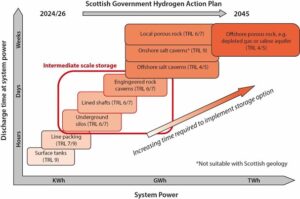
IDRIC Award “Assessing Regional Demand for Geological H2 Storage: Building A Strategic Case for Investment In The East Coast Cluster”
Hydrogen storage at Teesside is being developed on a case-by-case basis, through the development or repurposing of oversubscribed salt caverns – an approach that may fail to deliver the necessary hydrogen storage capacity within the required timeframes. Through stakeholder engagement with industry partners the project will deliver a comprehensive assessment of hydrogen storage demand – alongside a regional geological storage capacity assessment considering socio-environmental constraints. This project’s impact will be a regional perspective through stakeholder workshops, regional modelling, and in-depth analysis. The resulting strategic case will achieve the following objectives:
- Provide a first-of-a-kind assessment of the regional-scale, spatial, and temporal demand for underground hydrogen storage.
- Assess workable geological storage capacity considering socio-environmental constraints.
- Develop a prioritised roadmap to remove barriers to meet the storage demand.
IDRIC Award “Investigating novel fluid injection approaches for CO2 storage optimisation”
Transport and mixing in porous media is critical for CO2 geological storage (CGS) as it controls how much CO2 can be injected, sets maximum injection rates and resultant pressure footprint, determines the CO2 trapping mechanisms, and controls long-term stability and migration of the CO2 plume.
Much of the research into CGS focuses on core-scale and Darcy-scale observations where experiments are predominantly carried out under entirely pulse-free flow conditions. However, a handful of experimental observations from the field of subsurface contaminant remediation and inspired by nutrient transport in bones indicates that deliberately pulsing flow can lead to greatly increased mixing rates in porous media.
We expect similarly enhanced mixing to be seen in CGS and that this would translate into cost, time, energy and emissions savings through shorter injection periods, risk reduction through enhancing storage security, and act as a tool for managing the pressure footprint of the injection operation.
Through pore-scale numerical modelling, microfluidic experimentation, and a series of industry/academic stakeholder workshops, we will explore deliberately pulsing injection at high frequencies from once a minute to 10 times a second and its potential for increasing the transport and mixing of fluids injected into the reservoir. This project will uncover the mechanisms through which mixing is enhanced, design pulsed injection strategies tailored to different porous media types, evaluate opportunities for maximising impact and controlling the process, and finally to serve as pump priming for follow-on funding.
Edinburgh-Copenhagen Strategic Partnership Award “Technology, Security and Infrastructure Protection in the North Sea”
With the new aggressive foreign policies of Russia and growing global competition, the security situation in Europe has fundamentally changed. This has tremendous implication for the North Sea, which can now be consdered as a region of threats and security concerns. Notably, after the Nordstream attacks of September 2022 it is clear that in particular critical maritime infrastructures are very vulnerable in the region. This research collaboration investigates: how can infrastructures be better protected?
The North Sea is a site of complex critical maritime infrastructures including legacy infrastructures from the fossil fuel era, growing investments in large scale wind energy infrastructure, an expansive network of underwater electricity and data cables and pipelines, and a globally-significant site for future undersea carbon sequestration and ‘green’ and ‘blue’ hydrogen production. Accompanying this are extensive land-based support infrastructures, including fabrication facilities, support services, refineries, substations, and landfall points for pipelines and cables.
Securing these infrastructures from attacks, hazards, and unforeseen events poses challenges for the national security sector including the military, coastguard, police, intelligence services, and relevant government departments, and for industry’s own efforts in self-protection, early warning, remote sensing, building in resilience and repair. This project will co-produce new knowledge and understanding on the changing challenges of infrastructure security in the North Sea between scholars from multiple disciplines, the security sector, government, and industry.
Marie Curie Doctoral Network: SHINE “Safe underground Hydrogen storage IN porous subsurface rEservoirs”
Hydrogen is expected to play a key role in a future climate-neutral economy, enabling emission-free transport, heating and industrial processes as well as inter-seasonal energy storage. It is anticipated there will be a requirement for TW scale storage with discharge durations of many months, which can only be delivered by underground hydrogen storage in porous reservoirs.
SHINE will investigate the hydrogen/rock/pore fluid processes with the aim to assess the feasibility of subsurface hydrogen storage technologies within porous reservoirs, through 10 cutting edge research and training projects at doctoral level spanning from microbiology to geochemistry, geophysics, fluid dynamics, and geomechanics monitoring using laboratory, computational and in situ approaches.
The main research objectives of SHINE centres around the scientific challenges associated with hydrogen storage in subsurface porous media, namely exploring fluid, rock and microbial interactions, characterization and integrity of the reservoir/caprock and safety and monitoring of subsurface porous storage.
SHINE mission is to provide high-level training in the field of subsurface hydrogen storage technologies to produce a new generation of high achieving doctoral researchers skilled in a variety of innovative technologies necessary to support the low carbon energy transition. It aims to recruit 10 international Doctoral Candidates (DCs) to be assigned to a specific PhD course/doctoral project, to be monitored and supervised in their career development by the multidisciplinary expertise network of SHINE consortium.
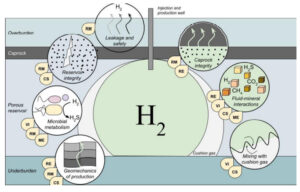
EU H2020 HyUsPRe (Hydrogen Underground Storage in Porous Reservoirs) Project
The HyUSPRe project researches the feasibility and potential of implementing large-scale storage of renewable hydrogen in porous reservoirs in Europe. This includes the identification of suitable geological reservoirs for hydrogen storage in Europe and an assessment of the feasibility of implementing large-scale storage in these reservoirs technologically and economically towards 2050. The project will address specific technical issues and risks regarding storage in porous reservoirs and conduct an economic analysis to facilitate the decision-making process regarding the development of a portfolio of potential field pilots. A techno-economic assessment, accompanied by environmental, social and regulatory perspectives on implementation will allow for the development of a roadmap for widespread hydrogen storage towards 2050; indicating the role of large-scale hydrogen storage in achieving a zero-emissions energy system in EU by 2050.
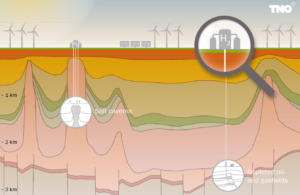
EU H2020 PilotSTRATEGY Project
The PilotSTRATEGY project is investigating geological CO2 storage sites in industrial regions of Southern and Eastern Europe to support development of large-scale carbon capture and storage (CCS).
We are focusing our research on deep saline aquifers–porous rock formations filled with brine several kilometres below ground – which promise a large capacity for storing CO2 captured from clusters of industry.
Detailed studies will be carried out on deep saline aquifers in the Paris Basin in France, the Lusitanian Basin in Portugal and the Ebro Basin in Spain. We will also enhance our knowledge of CO2 storage options in West Macedonia in Greece and Upper Silesia in Poland.
PilotSTRATEGY will also engage with citizens and stakeholders and ensure that community perspectives are fully represented in the project.
PilotSTRATEGY, funded by the European Union’s Horizon 2020 programme, involves 16 research partners from seven European countries and builds on research carried out by the STRATEGY CCUS project.

Previous projects
Hydrogen Storage Database
This project created an open acess resource that highlights the hydrogen storage potential in geological formations (lined rock caverns, salt caverns and depleted gas fields) across the UK.
This includes their locations, capacities and storage integrity factors. The hydrogen storage data is integrated with data on existing energy system assets, oil and gas infrastructure, renewable energy developments and wider considerations such as demand centres, land use, conservation areas etc.
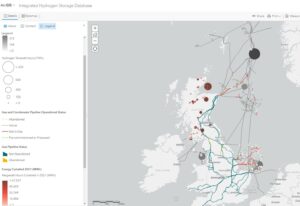
UKCCSRC CarbNET Carbonation negative emission technology project
To mitigate climate change and attain Net Zero emission by 2050, deep reductions in carbon dioxide emissions are urgently required. Achieving this requires continued reduction in greenhouse gas (GHG) emissions and essentially enhanced GHG decreases and storage. Buildings contribute a significant proportion of the UK’s carbon emissions (18%) and current policy focusses on reducing operational carbon emissions associated with the energy required to run buildings. However, many stakeholders, including the Climate Change Committee and COP26 recognise there needs to be an increased focus on the whole life embodied carbon emissions of buildings in support of the UK net zero carbon buildings strategy. As such reducing the embodied carbon of our built environment will play a key role in achieving net zero emissions targets.
This project investigates the concept of removing excess CO2 from the air and sequestering it as solid carbonate in alkali bases created from construction industry by-products and recycled construction materials for reuse as value added construction or industrial materials. 7 billion tonnes of alkaline materials are produced globally each year as a product or by-product of industrial activity. The aqueous dissolution of these materials creates high pH solutions (alkali bases) that could be used to dissolve captured CO2 and sequester it as a solid carbonate mineral or bicarbonate that can then enter a circular chemical economy – 50 million tonnes of sodium bicarbonate are used in industry every year.

The EPSRC HyStorPor project
To meet the UK commitment to reach net zero carbon emissions by 2050 our energy mix must transition from fossil fuels. Hydrogen can support this transition by replacing natural gas for domestic and industrial heat; replacing coal and natural gas for power generation; replace fuel oil and gasoline to decarbonise transport and facilitate increased renewable energy by acting as an energy store to balance supply and demand. For the deployment at scale of green hydrogen, produced from renewables, and blue hydrogen, produced from steam reformation of methane with CCS, large-scale underground storage in porous rocks will be essential to facilitate hydrogen as a low carbon energy pathway.
The HyStorPor project aims to establish the feasibility of storing hydrogen in underground porous reservoirs.
We will investigate the fundamental questions of what happens when hydrogen is being injected and withdrawn from subsurface reservoirs. These include possible chemical reactions between the hydrogen and the reservoir rocks. We will evaluate whether these reactions would have positive (increasing injectivity) or negative (loss of hydrogen) effects on hydrogen storage.
We will use our state-of-the-art facility to investigate and image the flow properties of hydrogen and in-situ pore fluid (brine). The resulting information will be used to calibrate computer models that simulate “injection and withdrawal” scenarios. These will provide estimates of hydrogen storage efficiencies – the percentage of hydrogen recovered during a typical injection-withdrawal cycle – as well as the hydrogen storage capacities of typical geological storage structures.
One of the essential aspects of future energy strategies is that they are developed in a way that respects and is responsive to social concern. We will investigate the social perception of hydrogen storage and engage with citizens to understand what shapes perceptions of alternative energy options.
After completion of HyPorStor, industry, researchers and public decision makers will have the knowledge-base to make justifiable decisions on the future of hydrogen storage in UK reservoir rocks.
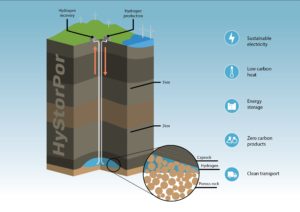
HyStorPor project
The EPSRC Prosperity Partnership, Smart Pumping for Subsurface Engineering project
This project is in collaboration with Strathclyde University and Weir Engineering, aimed at developing direct links between research and industry
The EU H2020 FracRisk project
This project is furthering the knowledge base for reducing the environmental footprint of shale gas development.
The development of unique Batch Reaction Experiments to determine the composition of produced water quality associated with hydraulic fracturing to investigate how the inherent properties of shales such as mineralogy, kerogen type, thermal maturity and formation fluids influence the anions, cations, metals, NORMS, CO2, H2S and hydrocarbon within the well clean-up, fracturing, flowback and production fluids generated during fracturing operations. This research informed the UK produced water wastewater management strategy.
The GREAT (GeoReservoir Experimental Analogue Technology) project
The GREAT project is in collaboration with the University of Gottingen and Heriot-Watt University.
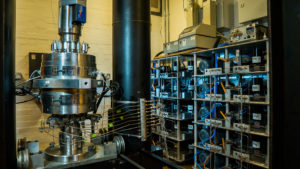
GREAT cell
Petrobras and Shell funded ICCR GeoMeChem project
Using unique multi-scale experimental and numerical investigations combined with machine learning to determine the key chemical and stress driven controls on dissolution and precipitation in carbonate rocks during brine flow.
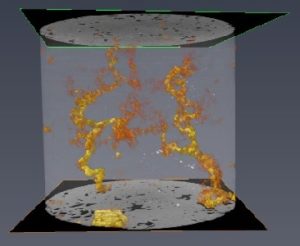
Carbonate wormhole
EU FP7 MiReCOL project
Research into near-surface CO2 leakage remediation methods to provide a comprehensive review of the available approaches to remediation of CO2 leakage in the near surface environment and the plans implemented to remediate the sites, including criteria used to assess the effectiveness of the methods and the costs of mitigation. While strenuous efforts will be made to minimise the risk of the leakage of CO2 from engineered storage sites, there will always remain a residual risk that CO2 could potentially migrate from the storage site into the shallow subsurface or atmosphere along permeable pathways such as faults or wells. CO2 leakage from geological storage will not necessarily negate the net reduction in CO2 emissions as it is physically impossible that all of the injected CO2 would be returned to the atmosphere during leakage due to the various trapping mechanisms operating within the subsurface. However the leakage must be controlled as it could ultimately result in the closure of the storage project; fining of the operator by the relevant authorities; the return of credits for carbon storage; and damage to the reputation of the site operator. Whether CO2 leakage occurs at high flow rates or is more spatially focussed and at slower rates there may be adverse health, safety and environmental risks associated with elevated levels of CO2 in the near surface. The impact of CO2 leakage will differ on a site by site basis; in some cases the effect may be negligible, where as in other cases it may cause serious human, agricultural, environmental or economic negative impacts.

CO2 remediation
Geomechanical Facies Methodology
The Geomechanical Facies Methodology isa predictive tool for site screening based on the influence of tectonic setting on depositional environment, which expresses the architecture of reservoir systems in terms of the engineering processes of interest and enables a multi-scale approach to characterisation of the system. The Geomechanical Facies Methodology has been applied to CO2 storage and unconventional hydrocarbon site characterisation.
Tracer Flow Experiments
Designed and built an innovative 1m long flow cell to conduct multiphase flow through experiments to establish the suitability of noble gases and other novel tracers for monitoring subsurface CO2 leakage.
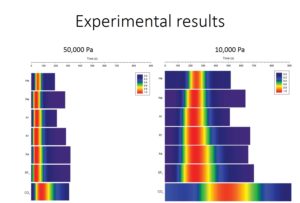
Tracer flow results
Risk Assessment of CO2 leakage
I have undertaken a number of subsurface risk assessment studies including the development of a comprehensive Features, Events and Processes (FEP) based framework for the assessment of risks involved in shale gas exploitation and an expert elicitation study to identify, assess and rank potential leakage risks at the Heletz field-scale experimental CO2 injection site.
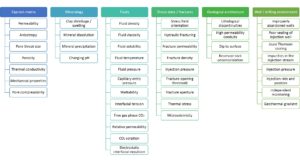
A New Methodology to Predict Rock Mechanical Properties from Porosity
The rock mechanical behavior of reservoir rocks is important in the design and implementation of drilling and production program. Traditionally rock mechanical properties are obtained from direct measurement on core samples or from mechanical calculations on acoustic wireline log measurements.I developed a new method of predicting rock mechanical properties directly from porosity. Porosity and rock mechanical property measurements were obtained from extensive rock mechanical testing on North Sea sandstone samples from an extensive range of oil and gas fields.
For any orientation of well, the greater part of the rock mechanical properties predictor is applicable and should produce accurate estimates of elastic and strength property data. Sound conventional analysis techniques on the wireline data prior to analysis is essential to provide the most representative base porosity log. The correlations of the rock mechanical properties with porosity are significant. The general all sediment relationship is an excellent starting point, but if the depositional environment is known it is advisable to apply the depositional specific correlations backed up with actual experimental data from the well or field being analysed. When the rock mechanical property logs calculated from the wireline porosity are compared to the experimental results a good degree of correlation is observed. Therefore it can be concluded that the rock mechanical property routine is an accurate, representative and cost effective method of obtaining a rock mechanical profile of the reservoir.
In vertical and moderately inclined wells, the coherent rock mechanical units provide an immediate profile of the overall mechanical nature of the reservoir and allows comparison and correlation both with other beds studied, throughout the wellbore section and from well to well across the reservoir area. Within horizontal beds, the inaccuracy of the rock mechanical units is more pronounced, and is a function of the distance travelled within a certain bed rather than the actual thickness of the bed studied. The applications of this routine are many and the sanding potential predictor described summarises the versatility of this routine to provide valuable data for a wide range of petroleum reservoir disciplines.
The benefits of the routine are that obtaining a representative rock strength profile of the borehole is relatively cheap, quick and requires very little input data. The porosity derived calculations also allow a more detailed quantification of the mechanical properties of the reservoir as only the modulus of elasticity and Poisson’s Ratio can be obtained from acoustic calculations.
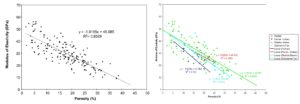
Porosity / Young’s Modulus



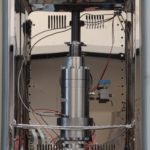

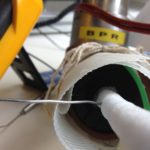

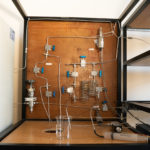
Comments are closed
Comments to this thread have been closed by the post author or by an administrator.